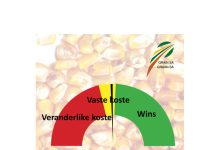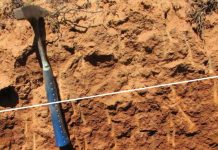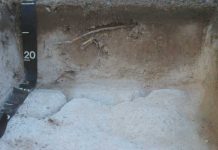Soil is the most fundamental resource for the farmer, without which food and natural fibre cannot be produced. This article forms part of a series to highlight this resource. This is the third article in the series which focuses on the physical properties of soils.
Soil deformation
Consistency
When a load is exerted on a body of soil, it will give way, deform, or crack. Consistency is the resistance that soil offers against this deformation agent and can be ascribed to the cohesive forces between the soil particles. The moisture content of the soil has a major influence on the consistency of the soil. The wetter the soil, the easier it will deform, while it may be very hard under dry conditions, offering major resistance to deformation.
Consistency is described as follows:
- In the dry state: loose, slightly hard, hard or very hard
- In the moist state: loose, crumbly, slightly firm, firm or very firm
- In the wet state: non-adhesive, slightly adhesive, adhesive or very adhesive
The consistency influences the tilth of the soil and root extension through the soil. Tillage of soil with a loose consistency is easier and roots also grow better in loose soil (but not too loose), than when the soil consistency is hard or very hard.
Soil strength
Soil offers resistance to deformation and a specific force is required to overcome the resistance level at which the soil will begin to deform. This resistance to deformation is due to the friction of soil particles when they slide over each other and when they are “torn” apart from their interlocking positions. Soils will then normally not return to their original positions after the force is removed.
When soil is pushed together by external forces, such as agricultural machines, the soil is placed under “stress” and one describes the soil as compacted or compressed. The effect this has on the physical state of the soil is, inter alia, that the soil strength (or resistance to deformation) is increased in the compacted zone, the bulk density is increased and the porosity (volume of pores) is reduced. Plant roots might therefore no longer grow through this layer. In agriculture, this resistance to deformation is measured with a penetrometer (Figure 1) and is usually illustrated in graphic format. Figure 2 indicates the compacted zone where the resistance to deformation is higher. The higher the soil strength, the greater the energy required by the tilling forces to overcome the resistant forces in the soil and to get the soil into a loose consistency once again.
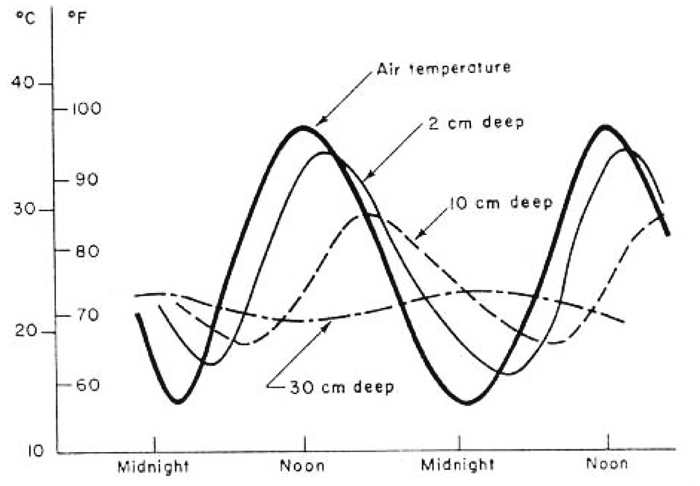
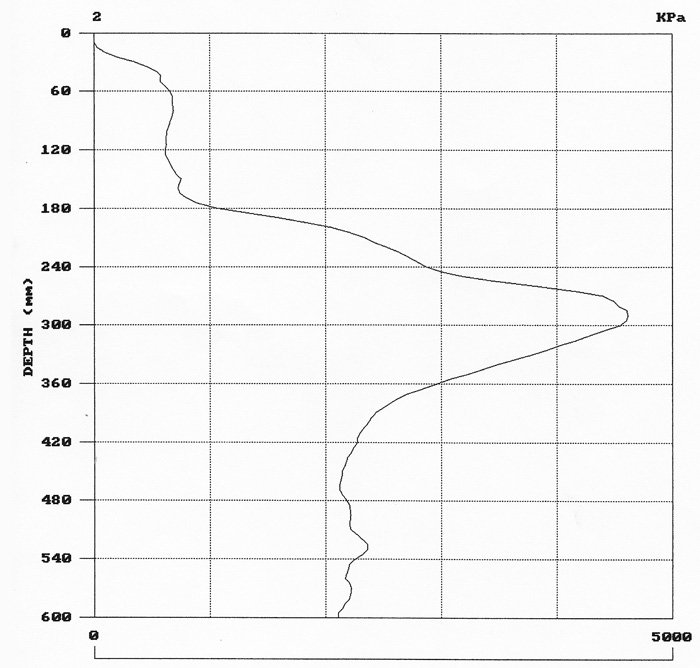
Natural deformation
Natural deformation takes place in clayey soils with strong expansion and contraction properties (2:1 montmorillonite clays). When the soil becomes moist it swells and when it dries out, it shrinks again to form cracks.
Soil temperature
Soil temperature influences the biological activities of plants, organisms living in the soil and microorganisms. For this reason, it is of great importance to the land user. Biological activities increase with an increase in the soil temperature, up to an optimal temperature of approximately 30°C. Maize roots grow best at a soil temperature of 25°C. Below 0°C, hardly any biological activity takes place anymore and for that reason mineralisation of organic material comes to a standstill. Nitrification bacteria also do not make any nitrate available under 10°C.
Soil temperature also has an effect on the rate of soil weathering and on the majority of chemical reactions in the soil. It also has an influence on the viscosity of water and therefore influences the rate of water movement in the soil and on the rate of evaporation of water from the soil as well.
Soil temperature is determined by a number of factors. Firstly, it is logical that the more energy the soil receives from the sun, the hotter it will be. Plants that overshadow the soil, plant residue that covers the soil and cloudy conditions will reduce the amount of energy reaching the soil and therefore the soil temperature. Lighter coloured soils will reflect more energy, while the darker soils will absorb more energy.
Soils on a northern slope (in the southern hemisphere) receive more energy than soils on a southern slope. About 10% of the total heat radiation of the sun is used for the heating of the soil.
On a sunny day, the first few millimetres of soil will be heated to 60°C and, on cold nights, could drop to below freezing. In these conditions, and as shallow as 100 mm, the day and night temperature in the soil can differ by as much as one half (Figure 1). At 200 mm, the range varies by only about 7°C, while at a depth of two metres, the soil temperature is virtually constant.
Moist soil conducts energy better than dry soil, because the water acts as a heat conductor between the soil particles. The heat conduction ability of water is about 25 times more than that of air. Therefore, moist soil will heat up deeper than dry soil. On the other hand, water needs five times more energy than dry soil particles to heat up. Wet soil will therefore heat up more slowly than dry soil. When water evaporates from the soil, it also uses large quantities of energy and has a cooling effect on the soil. Furthermore, clayey soils conduct the energy better than sandy soils, because there are far more contact surfaces between the soil particles.
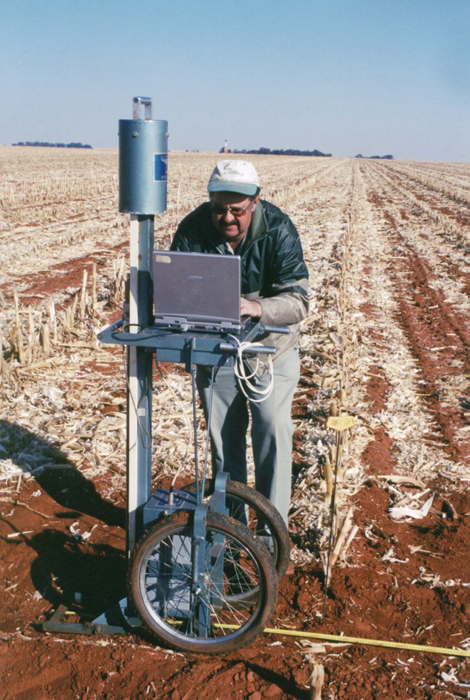
Soil colour
Apart from its effect on soil temperature, soil colour does not have any direct significant effect on soil utilisation. This characteristic is, however, used to deduce other soil properties that do influence land use, while also being used to classify soil types.
Soils mainly comprise white or off-white minerals, of which quartz (white or translucent) is the most abundant. Other lightly coloured minerals are lime, aluminium oxides, feldspars and some of the clay minerals. The most important colouring agents in soil are: humus (black or brown), iron oxides (yellow to red and grey to blue-green), magnetite (black), manganese oxides (brown-black), augite (black), hornblende (black) and biotite (dark brown). These colouring agents play an important role in soil colour, although the absolute content thereof is minimal, because it only covers the soil particles, thus “painting” them.
In the upper layers of soil, humus makes a major contribution to the darkening of soils. In general, it is accepted that the darker the soil, the higher the humus content. However, in some well-drained humus-rich soils, hematite (a red iron oxide) can colour the humus red. Such soils could therefore have a high humus content, even though they are red in colour and not dark.
The bright red colours of drained subsoils may be ascribed to hematite which covers the soil particles. Under a microscope, it really appears as though the white or translucent soil particle has been painted red. The yellow colours may be ascribed to goethite (a yellow iron oxide). Yellow colours may be ascribed to a slightly moister soil water regime than those of red soils, in the same region. In subsoils that are subject to regular waterlogging, the iron is reduced, removed and relocated, leading a mottled, or grey to blue-green colour in the soil. The occurrence of iron minerals and the colour patterns thereof are therefore valuable indicators of the long-term water regime of the soil.
Summary
Apart from the hydraulic (water) characteristics of the soil, the most important physical properties of soil have been dealt with in the past three articles. These properties have a significant impact on the land use and farming, as they directly affect plant growth. Some of these properties can be manipulated to optimise plant growth and it is therefore important for the land user to understand these soil characteristics and how they can be manipulated to promote plant growth.
For further information, please contact Martiens du Plessis at 072 285 5414 or martiens@nwk.co.za or Cornie van Huyssteen at 051 401 9247 or vanhuysteencw@ufs.ac.za.
References
The following sources were used extensively during the compilation of this article:
- Brady, NC. 1990. The nature and properties of soils. 10th ed. Macmillan publishing company: New York.
- Du T Burger, R. 1979. Soil Science 115. Unpublished class notes for GKD115. University of the Free State: Bloemfontein.
- Marshall, TJ and Holmes, JW. 1979. Soil Physics. Cambridge University Press: Cambridge.




